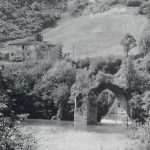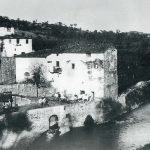The Ponte di Valle, later known as the Ponte dei Romiti or Romito, takes its name from the presence of hermitages, areas where ancient hermits would retreat to isolate themselves and pray. The “hospitals” were located on the right bank of the Arno, in the area known as dell’Isola or dell’Isoletta, near San Cataldo at the Ponte di Valle, and on the left bank of the river, further south, towards Pieve a Maiano (Civitella in Val di Chiana).
At the bridge, there were mills, essential structures in the medieval economy, which belonged either to the Abbey of Agnano or to the community of Laterina. Starting from the 1700s, the Busatti family engaged in a long dispute (which continued until 1761, carried on by their heirs, the Rossi family) with the Municipality of Laterina, concerning the lands around the Arno weir and the “communal” mill (i.e., the mill leased by the community).The aforementioned Ponte di Valle or Romito, which connected the two banks, had four arches with a low-sprung design, made of sandstone blocks (its supposed Roman-imperial origin, recently suggested, seems unlikely, nor do the construction techniques support this claim).In 1705, the Romito Bridge was rebuilt about 200 meters downstream, after a flood had caused two of the three piers to collapse in 1703.
It was only in 1757, at the initiative of Giovanni Ginori, that the area was reclaimed and the Arno River was channeled for about two miles between the Montoto hill and the Ponte Romito, based on a project by engineer Antonio Falleri. The works, which also involved the Oreno and Bregine streams, were completed in the early 1800s.
In 1777, with the new road alignment following the course of the ancient Cassia Nova, the Romito Bridge and the road to Laterina and Monsoglio lost their territorial importance. The road itself was downgraded and came to be known as Via Vecchia Aretina (the Old Aretina Road).
Today, what remains of the old bridge is considered an important historical and cultural monument, being one of the oldest Roman bridges in the Tuscany region, alongside others such as the Ponte Buriano and the Ponte alla Badia.






